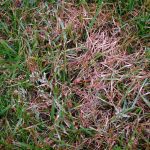
Visit anybody here in Southern Ontario, and the discussion is sure to turn to the weather… specifically the amount of rain we have had this spring and summer.
According to Environment Canada, Hamilton Ontario has received 220% more rain in April 2013 than in April 2012, 360% more rain in May 2013 than in May 2012, and approximately 6% more rain in June 2013 than June 2012; an average of 195% more rain in the first three growing months of the season. So what does this mean for your lawns? Unfortunately it means drowning and fungal diseases.
## Drowning
Plant roots need air to survive. Most people understand that roots hold plants in place and absorb water and nutrients from the soil. But many people don’t realize that roots need air to perform these functions. Wet or water-logged soils don’t have any air. You can’t breathe and live under water, and neither can plant roots. With all this rain the grass and many plants are going to struggle. If the lawn is soaking wet for too long the roots will essentially drown and the grass will struggle and possibly die. As species are concerned, creeping bentgrass has excellent submersion tolerance followed by tall fescue, Kentucky bluegrass and perennial ryegrass, with the fine leaf fescues rounding out the poor end of the spectrum.
## Diseases
Most turfgrass and landscape diseases thrive in warm, moist conditions. All that rain, heat, and humidity have been helping the diseases go crazy. Moreover, diseases and insects like to attack weak and damaged plants – adding more trouble to already damaged plants. Here are a few fungal diseases we are seeing already (see images for examples):
### Anthracnose (Colletotrichum graminicola)
Occurs particularly in spring through late summer, in heavy traffic and poorly drained areas. There will be irregularly shaped patches of yellowish-bronze areas ranging from 2” to several feet. Leaf lesions usually appear as elongated reddish-brown spots on leaves which may encompass the entire grass blade. Black fruiting bodies with tiny spines may also appear on foliage.
– Control Options (Several cultural practices will help control diseases on lawns):
– Proper watering practices
– Increase your lawn mower height (3”)
– Avoid over watering your lawn
### Pythium (Pythium sp. Several)
When weather turns hot and humid, the fungi grow extremely rapidly causing infection and discoloration in a matter of hours. Outbreaks have been known to severely damage lawns in less than 24 hours.
– Control Options (Several cultural practices will help control diseases on lawns):
– Correct any drainage problems in your lawn
– Avoid over watering
– Aeration may help
– Improve air circulation by thinning trees overhanging your lawn
– Use a balanced fertilizer program (do not over fertilize)
### Red Thread (Laetisaria fuciformis)
Occurs in cool, moist periods of spring and fall. It lives in soil, thatch and dead leaves all year round. Ragged patches of red to pink threads appear on the grass blade and sheath. Your lawn may appear from a distance to be suffering from lack of water. Red Thread looks like Leaf Spot and Dollar Spot.
Some factors which may encourage the spread of the disease are poor air circulation, poor drainage and a thick thatch layer. It spreads throughout the lawn in the form of spores. Wind, air, water, animals and humans spread these spores.
Red Thread attacks most types of grass but is generally found on lawns with low soil fertility that contains a high proportion of fescue and ryegrass.
Control Options (Several cultural practices will help control diseases on lawns):
– Increase air circulation
– Reduce shade areas
– Dethatching or aeration may help
– Proper watering
– Use a balanced fertilizer program (do not over fertilize)
– Maintain a soil pH of 6.5 – 7.0
### Rusts (Puccinia species)
Occurs in late summer or fall affecting cool season grasses. Perennial Ryegrass is the most susceptible and Kentucky Bluegrass is less susceptible.
Rusts is most active during temperatures of 22‑25C with a high humidity. Alternating weather patterns of cool and wet to hot and dry can also cause rusts. Rusts survive on the living and dead leaf tissue and in the thatch layer of turfgrass or on alternate hosts (ornamental plants).
Rusts appears as light yellow flecks on the leaves and sheaths, followed by reddish‑brown coloured spores. Rusts spores can be rubbed off easily, giving a reddish tinge to shoes and equipment. In most cases the rusts simply wilts the blades but in some extreme cases rusts can permanently damage your lawn.
Control Options (Several cultural practices will help control diseases on lawns):
– Increase mower height (3”) and frequency
– Proper watering practices
– Use a balanced fertilizer program
– Increase air circulation
– Overseed with disease resistant varieties
## Long Range Forecast, July & August
Unfortunately for our grass, it does not look like this wet weather will be letting up any time soon. Here is what the Farmer’s Almanac is predicting for Ontario the rest of the summer.
### JULY 2013
**Temperature 20°C (0.5°C below average.) ~ Precipitation 100mm (20mm above average)**
**Jul 7-12:** Sunny east, t-storms west; hot
**Jul 13-18:** Scattered t-storms, warm
**Jul 19-24:** Sunny east, t-storms west; cool
**Jul 25-29:** T-storms, then sunny, warm
**Jul 30-31:** T-storms, hot
### AUGUST 2013
**Temperature 18.5°C (1°C below average) ~ Precipitation 105mm (20mm above average)**
**Aug 1-5:** T-storms, then sunny, cool
**Aug 6-13:** Scattered t-storms, cool
**Aug 14-18:** T-storms, turning hot
**Aug 19-25:** Sunny, cool
**Aug 26-31:** Scattered t-storms, warm
Let us know how you are coping with this weather!



